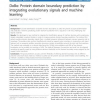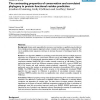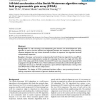197 search results - page 27 / 40 » Improving pairwise sequence alignment accuracy using near-op... |
102
click to vote
BMCBI
2005
14 years 11 months ago
2005
Background: Pairwise stochastic context-free grammars (Pair SCFGs) are powerful tools for evolutionary analysis of RNA, including simultaneous RNA sequence alignment and secondary...
SC
2003
ACM
15 years 5 months ago
2003
ACM
This paper presents a novel, parallel algorithm for generating top alignments. Top alignments are used for finding internal repeats in biological sequences like proteins and gene...
127
click to vote
BMCBI
2011
14 years 6 months ago
2011
Background: Accurate identification of protein domain boundaries is useful for protein structure determination and prediction. However, predicting protein domain boundaries from a...
BMCBI
2008
14 years 12 months ago
2008
Background: Amino acids responsible for structure, core function or specificity may be inferred from multiple protein sequence alignments where a limited set of residue types are ...
BMCBI
2007
14 years 12 months ago
2007
Background: To infer homology and subsequently gene function, the Smith-Waterman (SW) algorithm is used to find the optimal local alignment between two sequences. When searching s...



